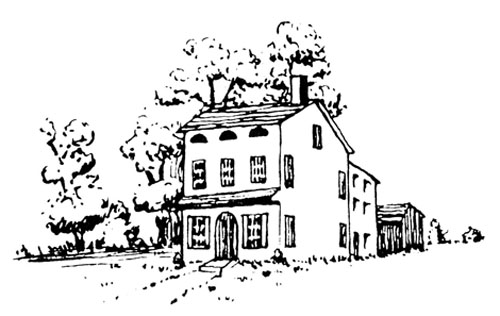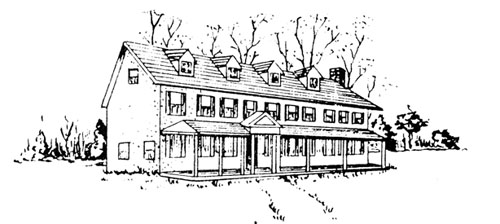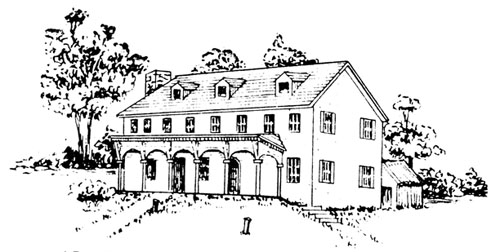|
Home : Quarterly Archives : Volume 23 |
Tredyffrin Easttown Historical Society |
|
Source: April 1985 Volume 23 Number 2, Pages 41–44 Tales of Local Taverns Since the bicentennial celebration, it seems to me that there has been a growing interest in Americana - an interest in the simple, country way of life. More and more people are moving from the city into the country, almost as if in rebellion against the sense of lost innocence which is so prevalent in our nation. I can think of no better place to recapture that sense of innocence and simplicity than in the historic inns and taverns of Chester County. Through old diaries and personal letters I have been introduced to both romantic and murderous characters involved with these old inns, all of whom have left their mark on all us here in Chester County today. It all begins well over two centuries ago, when people from England, Wales, and Germany came to this land in pursuit of a common dream, a dream of freedom and prosperity. A group of immigrants from Cheshire, England found the fresh, virgin beauty of their new environs so like their former home that they settled in for a permanent stay. Others continued onward, steering their horse-drawn wagons westward over the coarse dirt road known as the Conestoga Road or King's Highway. Along the way, inns and taverns, to serve the weary traveler, soon became essential to colonial life. These roadside way stations soon became centers for social, religious, and political events. In later years they also served as hospitals, post offices, and stage coach stops, as well as courtrooms and military outposts. Many of them were kept by men of great prestige and political power. In them, incidents of every nature have taken place.
BLUE BALL TAVERN S0UTH OF LANCASTER ROAD BUILT 1735 RELOCATED NORTH OF ROAD 1790. NEAR 17th MILESTONE One inn with which you are all familiar is the Blue Ball in Daylesford. As you all know, many travelers - peddlers and truckers weighed down with the profits from selling their wares in Philadelphia - who stopped here on their way back from the city were never seen or heard from again. Miss Prissy - Priscilla Moore Robinson, the proprietress and innkeeper of the Blue Ball - saw to that! Each of her three husbands, Edward Robinson, John Cahill, and John Fisher, incidentally, also vanished mysteriously, while Prissy lived to the age of 100. In 1894 the house was sold and became a private residence. The Lamb tavern, in what is now Devon, and which some of you may now know as "Roughwood", was also one of our earliest taverns. The tavern was originally started in two log buildings. Between 1809 and 1812 they were used as an iron depot by wagoners hauling pig iron from the furnaces at Warwick and Coventry into Philadelphia. To make their ascent up the long hill from Valley Forge, the wagoners were forced to leave half their load at the Bull Tavern, in Schuylkill Township. After depositing the remainder at "Rees' store", as the depot was then called, they would then head back to the Bull to collect the other half. Desperately needing a place to rest before continuing to the city, the wagoners petitioned for a tavern at George Rees' country store. In 1815, when Jacob Clinger, a Pennsylvania German, became the innkeeper, he and his wife immediately transformed it into a first-class stand for stage coaches. To accommodate their now high class clientele, they put a new tavern on the site of the former log buildings. By the 1880s and 1890s, wealthy Philadelphians, looking for summer homes, came to Devon to escape the city's heat. They found the Lamb, surrounded by trees, cool and breezy on even the most sweltering days. In the early 1900s it was purchased for a residence by Mistress Suzanne Wister Fuget, who immediately ordered her gardener to plant wisteria vines around the entire property. In 1928 the house was renovated by the renowned architect, R. Brognard Okie, at a cost of $38,000. When the Pennsylvania Fireworks Company exploded on April 3, 1930 the house was shaken violently, and in the seconds that followed, both the roof and the chimney were torn from their fittings. The damage caused by the blast was tremendous, and much of Okie's work was destroyed. Hard times fell on the house, and when it was purchased by William Woys Weaver, a talented writer and author of several books on American cookery, in 1979 it required much attention. Since then he has restored it to what it looked like in the 1800s, with the cage bar and the old double verandah that ran along the western side of the building. The original liquor cabinet that hung behind the bar in the 1820s was located and returned. After months of research, he also found that in order to provide the guests with food that was absolutely fresh, a number of outbuildings had been connected to the tavern, such as an ice house, a granary, a chicken coop, a large dairy, and a piggery.
THE GENERAL PAOLI TAVERN 1763.ON LANCASTER ROAD WEST OF 18th MILE STONE. An old tavern no longer standing was the General Paoli. When it opened on St. Patrick's Day in 1769 a name for it had not yet been chosen. That evening, in the midst of much celebration, a toast was made to the name of General Pasquale Paoli, the Corsican general renowned as a champion of liberty. As the mugs were emptied, Joshua Evans, the innkeeper, had decided on the name; from that night on it would be called the General Paoli. When the new turnpike was completed in 1794- it went directly in front of the General Paoli, insuring an era of prosperity for the tavern. In the early 1800s, after Joshua Evans junior took over his father's place as innkeeper, it became a major stop for almost every stage line. Even after the Columbia Rail Road was built, the General Paoli continued to thrive. Conveniently, the tracks of the new railroad also ran quite close to the inn, and the workers and patrons of the railroad provided a steady business. Since Evans had just been elected to Congress, many less fortunate rival innkeepers believed he had exerted his influence in planning the railroad's route.
ADMIRAL WARREN TAVERN 1745 NEAR 20th MILESTONE A mile or so farther to the west is the Warren tavern. It played an important part in the Revolution, It was run at that time by a Peter Mather, a strong British loyalist, and it became a gathering place for Tories and opponents of the revolutionary cause. It is believed that the British Major John Andre lingered here to map out the countryside and prepare the plans for the capture of Philadelphia that were followed by Howe and Cornwallis in the fall of 1777. It is also believed that on the night of September 20, 1777 it was a blacksmith from the Warren tavern, wearing the blue coat of the rebel cause, who guided the Hessian and Black Watch soldiers under General Charles Grey to General Wayne's camp prior to the "Paoli Massacre". It was also a rumor that the only way Wayne escaped that night was to take off his coat and turn it inside out, to display its red lining, passing himself off as a British officer; hence the word "turncoat". But Wayne denied these rumors, and no such charges were ever brought against him. After the Revolutionary War the Warren was taken over by the Fahnstock family, who were Pennsylvania Germans. They turned it into a first-class stage coach tavern. The stage driver, on his way down the hill into the Valley, would give a number of toots on his bugle to tell the host of the Warren how many guests to expect for dinner. Illustrations by Franklin Wandlessfrom his "Historical Map of Easttovn & Tredyffrin Townships" |


